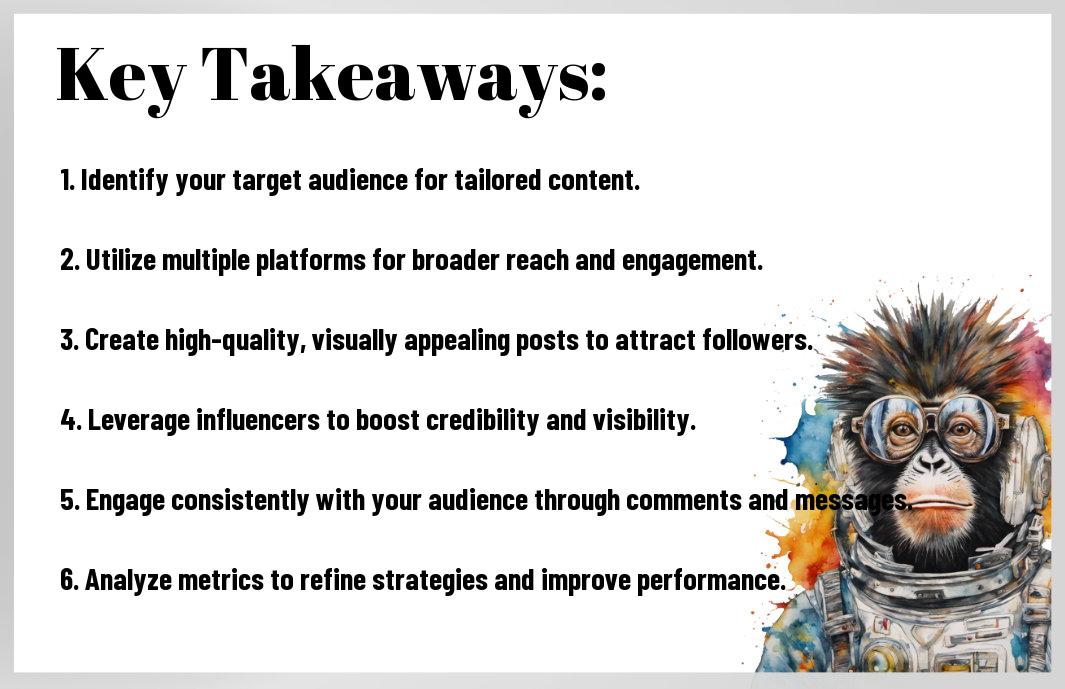You might be wondering how to maximize your returns from affiliate marketing using social media. In this blog post, I will share key strategies that can enhance your online presence and drive conversions. By understanding your audience and selecting the right platforms, I’ll guide you through engagement techniques that not only boost your visibility but also foster trust with your followers. Let’s explore the effective approaches that can elevate your affiliate marketing game through social media.


Understanding Affiliate Marketing
While the concept of affiliate marketing might seem straightforward, it encompasses a variety of strategies and processes that can significantly impact your success. At its core, affiliate marketing allows individuals or companies to earn commissions for promoting products or services offered by another business. By leveraging your online presence, you can drive traffic to a merchant’s website, all while benefiting from your promotional efforts. This system creates a win-win situation: merchants gain more exposure and sales, while you, as an affiliate marketer, can enjoy passive income without the need to create your own products.
Definition and Purpose
Along with being a performance-based marketing strategy, affiliate marketing serves as a bridge between consumers and businesses. Through this system, you not only earn passive income but also provide valuable recommendations to your audience, helping them make informed purchasing decisions. The purpose behind affiliate marketing is to build a network of partnerships that can thrive on shared interests, driving mutual growth for both affiliates and businesses.
Key Players in Affiliate Marketing
For anyone venturing into affiliate marketing, it’s important to understand the roles of key players involved in the process. The main participants are the affiliate (you), the merchant (the seller), and the customer. As an affiliate, your role is to promote the merchant’s products, directing potential customers to their offerings. The merchant provides the products and typically has the infrastructure in place for tracking sales and managing commissions. Lastly, the customer is pivotal in this ecosystem as they are the ones making purchases based on your recommendations, thereby completing the cycle.
At the heart of affiliate marketing, these dynamic relationships form a powerful synergy. The affiliate drives traffic, leveraging their audience to create interest in the products. The merchant benefits by gaining exposure and increasing sales without the need to invest heavily in traditional marketing strategies. Finally, the customer enjoys a curated shopping experience, often discovering products that fulfill their needs and preferences. To be successful, understanding these roles and building solid relationships with each player is necessary in growing your affiliate marketing endeavors.
The Role of Social Media in Affiliate Marketing
There’s no denying that social media plays a significant role in the success of affiliate marketing. As I’ve explored various marketing strategies, I’ve noticed that social platforms serve as powerful channels to promote affiliate products and connect with potential customers. They offer a unique space where I can share engaging content and build a community around my niche, ultimately driving traffic to my affiliate links. Platforms like Instagram, Facebook, Twitter, and Pinterest allow you to reach diverse audiences, enabling you to tailor your messaging and content to suit the preferences of each platform’s users.
Overview of Social Media Platforms
Beside the major platforms mentioned earlier, there are numerous others, such as TikTok and LinkedIn, that can greatly benefit your affiliate marketing efforts. Each platform offers unique features that I can leverage for promoting products effectively. For instance, TikTok’s short-form video content can be used for creative product demonstrations, while LinkedIn is perfect for targeting professionals in specific industries. Understanding the strengths of each platform will enable you to choose the right ones for your affiliate marketing campaigns.
Benefits of Using Social Media
Media platforms offer an array of benefits for affiliate marketers like myself. For starters, they facilitate direct interactions with your audience, allowing you to build relationships and trust. This engagement can lead to higher conversion rates, as potential customers feel more connected to recommendations from individuals rather than faceless brands. Moreover, social media allows for the sharing of valuable content, providing opportunities to educate your audience and position yourself as an authority in your niche.
This connection not only enhances the overall user experience but also increases the likelihood of purchases through your affiliate links. Additionally, social media provides access to comprehensive analytics that help you track performance and optimize future campaigns. Leveraging targeted advertising can further boost visibility and reach, making it easier to attract potential customers. With diligent effort and a clear strategy, you can harness the power of social media to drive your affiliate marketing success. Always keep in mind the importance of creating authentic content and engaging with your audience genuinely to maximize your results.
Developing a Social Media Strategy
After assessing the landscape of affiliate marketing, it becomes clear that developing a robust social media strategy is vital for success. Your strategy should encompass various aspects, including content creation, engagement tactics, and channel selection. I believe that a well-thought-out social media plan will not only enhance your online presence but also increase your chances of generating significant affiliate revenue.
Identifying Your Target Audience
To craft an effective social media strategy, you must first identify your target audience. This step involves understanding who your ideal customers are, their preferences, and where they spend their time online. I recommend gathering insights through surveys, social media analytics, and market research to pinpoint key demographics. Once you know your audience, you can tailor your messaging and content to engage them effectively.
Setting Clear Goals
To ensure that your social media strategy is actionable and measurable, it’s important to set clear goals. I suggest thinking about what you want to achieve—whether it’s building brand awareness, increasing website traffic, or boosting sales through affiliate links. By establishing specific, measurable goals, you create a roadmap that guides your efforts and allows you to track progress over time.
Setting these goals should involve identifying not only what you want to achieve but also how you’ll measure success. I find it beneficial to utilize metrics such as engagement rates, click-through rates, or conversion statistics as indicators of whether you’re on the right path. Furthermore, you should periodically reassess your goals to ensure they align with your overall marketing strategy and adjust them as necessary for optimal results.
Content Creation for Affiliate Marketing
Once again, I want to emphasize that effective content creation is at the heart of successful affiliate marketing. You’ll need to produce high-quality content that not only attracts your audience’s attention but also drives conversions. This can range from engaging blog posts to detailed product reviews and captivating social media updates. Effective content showcases the value of the products or services you are promoting while aligning with the interests and needs of your audience. Additionally, using keywords strategically throughout your content must be part of your approach to improve visibility in search engines.
| Type of Content | Purpose |
|---|---|
| Blog Posts | To provide detailed information and insights |
| Social Media Updates | To engage and connect on a personal level |
| Video Content | To demonstrate products in action |
| Email Newsletters | To keep your audience informed and engaged |
| Infographics | To present information in an easily digestible format |
Types of Content That Drive Engagement
Recognizing the diverse types of content that resonate with your audience can significantly boost engagement. Consider utilizing the following:
- How-to Guides to educate your audience.
- Product Comparisons to help customers make informed decisions.
- Listicles to provide quick, digestible information.
- User-generated Content to build trust through community engagement.
- Case Studies to showcase success stories using your products.
Using Visuals Effectively
Above all, incorporating visuals into your content strategy is necessary for affiliate marketing success. Visual elements, such as images, infographics, and videos, grab attention, convey messages more effectively, and enhance overall user experience. By presenting information visually, you can convey complex ideas in a format that is easier for your audience to process. This, in turn, can increase sharing potential and engagement.
Content that includes high-quality images of products, engaging videos, and well-designed infographics significantly boosts user interest. Additionally, using visuals that resonate with your target audience can evoke emotional responses and drive action. Therefore, I recommend using visuals to complement your written content, ensuring that both elements work together to convey your message compellingly and memorably.
Leveraging Influencer Partnerships
Unlike traditional advertising methods, partnering with influencers allows you to tap into their established trust and rapport with their audience. This can lead to enhanced visibility and a higher conversion rate for your affiliate marketing efforts. Influencers are often seen as relatable figures who provide authentic recommendations, making it easier for your product or service to gain traction. By aligning your affiliate products with the right influencers, you’re not just promoting a product but also integrating it into a genuine narrative that resonates with their followers. This approach can significantly elevate your marketing strategy if executed correctly.
Finding the Right Influencers
After identifying the niche for your affiliate products, the next step is to locate influencers who align with your brand’s values and target audience. Start by researching social media platforms where your potential customers spend their time. Look for influencers who have a strong engagement rate and a genuine connection with their followers. Tools like social media analytics can assist you in evaluating influencer performance by providing metrics on reach, engagement, and follower demographics. Choosing the right influencer is pivotal; their audience should mirror your target market to maximize the impact of your campaigns.
Building Effective Collaborations
Collaborations with influencers should go beyond merely exchanging products for posts. You must ensure that the partnership feels authentic and adds value to both parties. Establish clear communication regarding expectations, such as the type and frequency of content, while also being open to the influencer’s creative process. It’s beneficial to co-create content that showcases your affiliate products in a way that feels organic to the influencer’s style, ensuring that their audience perceives the promotion as a natural recommendation rather than a paid ad.
Finding an agreement that benefits both you and the influencer can lead to long-lasting relationships and more successful collaborations in the future. Consider offering incentives beyond monetary compensation, such as affiliate commissions, exclusive discounts, or early access to new products. This not only motivates influencers to promote your products authentically but also fosters loyalty that can result in ongoing promotions and referral traffic. Ultimately, when both parties feel valued, they’ll be more invested in the success of the partnership, enhancing your affiliate marketing efforts significantly.

Analyzing and Measuring Success
Keep in mind that understanding your performance on social media is important for optimizing your affiliate marketing efforts. By regularly analyzing your strategies, you can make data-driven decisions to improve your outcomes. If you’re unsure about where to start, check out this resource on How to Get Started With Social Media Affiliate Marketing. Tracking your progress will enable you to identify what resonates with your audience and refine your approach accordingly.
Key Metrics to Monitor
Measuring the right metrics is fundamental to gauge the success of your social media affiliate marketing campaigns. It’s important to focus on indicators such as engagement rates, click-through rates (CTR), conversion rates, and audience growth. Engagement rates can reveal how well your content is performing, while CTR indicates how effectively your calls to action are resonating with your audience. Additionally, monitoring conversion rates will help you understand how many of those clicks are turning into actual purchases, providing a clear picture of your ROI.
Tools for Performance Tracking
Between the myriad of analytics tools available, it’s vital to choose the ones that best suit your needs for tracking performance. Platforms like Google Analytics, Hootsuite, and Buffer provide comprehensive insight into your social media performance, allowing you to monitor traffic sources, user behavior, and overall engagement. These tools not only help in gathering data but also make it easier to visualize your performance trends over time.
For instance, if you utilize Google Analytics, you can set up specific goals to measure conversion rates effectively. You’ll gain access to detailed reports that show which social media channels are driving the most traffic and conversions to your affiliate links. Additionally, with tools like Hootsuite, you can schedule posts while simultaneously monitoring audience engagement in real-time. By leveraging these performance tracking tools, you can gain deeper insights into your audience and tailor your strategies to maximize your success in affiliate marketing.
Summing up
Now, as I reflect on the most effective social media strategies for affiliate marketing, it’s clear that a tailored approach is imperative. You must focus on understanding your audience and creating content that resonates with them. Engaging storytelling, authentic interactions, and strategically placed affiliate links can significantly bolster your marketing efforts. I find that selecting the right platforms where your target audience spends their time also plays a pivotal role in the success of your campaigns.
Additionally, utilizing analytics to track your performance can provide valuable insights. I encourage you to consistently analyze which strategies yield the best results and adapt accordingly. For those looking to dive deeper, this Guide to Social Media Affiliate Marketing offers a comprehensive look into crafting effective strategies tailored to your needs. By implementing these practices, you can maximize your affiliate marketing potential through social media.
Click here to unlock the potential of daily pay recurring incomes through social media.
FAQ
Q: What is the importance of choosing the right social media platforms for affiliate marketing?
A: Selecting the appropriate social media platforms is vital because each platform has its unique audience and engagement style. For instance, Instagram and Pinterest are highly visual, making them effective for promoting products with strong visual appeal, such as fashion or fitness items. On the other hand, LinkedIn works well for B2B affiliate marketing since it caters to professionals. By aligning your affiliate products with the most relevant platforms, you can reach a more targeted audience, leading to higher engagement and conversion rates.
Q: How can content creation enhance my affiliate marketing efforts on social media?
A: Content creation plays a significant role in affiliate marketing as it helps build trust and establish authority in your niche. By producing high-quality, informative, and engaging content, you can effectively inform your audience about the products you are promoting. This includes creating tutorials, reviews, and comparison posts that showcase the benefits of the products. Additionally, using various formats like videos, infographics, and stories can cater to different preferences among your audience, further enhancing engagement and driving traffic to your affiliate links.
Q: What are effective techniques for building and engaging an audience on social media for affiliate marketing?
A: Building and engaging an audience on social media requires consistency and interaction. Start by posting regularly to keep your audience engaged and informed. Utilize hashtags, engage in trending topics, and collaborate with influencers in your niche to expand your reach. Moreover, participating in conversations, responding to comments, and running polls or contests can create a sense of community among your followers. Additionally, using targeted ads can help you reach potential customers who are interested in your niche, increasing the chances of conversions through your affiliate links.



